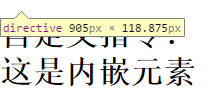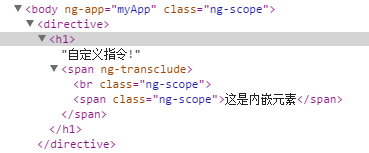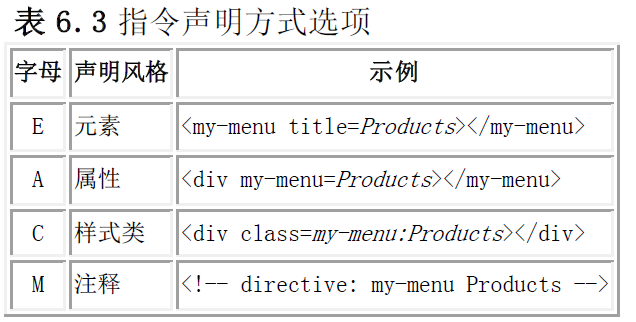AngularJS中Directive(指令)機制詳解
阿新 • • 發佈:2019-02-05
AngularJS 通過被稱為 指令 的新屬性來擴充套件 HTML。
AngularJS 通過內建的指令來為應用新增功能。
AngularJS 允許你自定義指令。
指令的作用:實現語義化標籤。
使用AngularJS的directive(指令)機制,我們可以實現這樣的東西:
<body ng-app="myApp">
<directive></directive>
<script src="js/angular.js"></script>
<script>
var app = angular.module("myApp" 結果是:

html標籤結構如下:

可以看到瀏覽器可以解析自定義的directive指定,將自定義指令替換成template中的內容。這就是replace:true的作用,至於restrict:’E’這個配置項的含義,請看下錶:
你可以限制你的指令只能通過特定的方式來呼叫。通過新增 restrict 屬性,並設定只值為 “E”, 來設定指令只能通過元素名的方式來呼叫。
restrict 預設值為 EA, 即可以通過元素名和屬性名來呼叫指令。
transclude(變換):
<body ng-app="myApp">
<directive><br>
<span>這是內嵌元素</span>
</directive>
<script src="js/angular.js"></script>
<script> 結果是:

html標籤結構變成了這樣:

程式碼裡面多了個transclude:true,於是內部出現了子標籤。
transclude就是用來處理自定義標籤內出現子標籤的情況。
關於compile和link
指令的本質其實是一個替換過程。這個過程分2個階段,也就是compile(編譯)和link(連線)。
簡而言之,compile階段進行標籤解析和變換,link階段進行資料繫結等操作。這裡面更加細節的處理過程請參見《AngularJS》這本書中的解析。
舉個栗子
var expanderModule=angular.module('expanderModule', [])
expanderModule.directive('expander', function() {
return {
restrict : 'EA',
replace : true,
transclude : true,
scope : {
title : '=expanderTitle'
},
template : '<div>'
+ '<div class="title" ng-click="toggle()">{{title}}</div>'
+ '<div class="body" ng-show="showMe" ng-transclude></div>'
+ '</div>',
link : function(scope, element, attrs) {
scope.showMe = false;
scope.toggle = function toggle() {
scope.showMe = !scope.showMe;
}
}
}
});
expanderModule.controller('SomeController',function($scope) {
$scope.title = '點選展開';
$scope.text = '這裡是內部的內容。';
});
HTML程式碼:
<html ng-app='expanderModule'>
<head>
<meta http-equiv="content-type" content="text/html; charset=utf-8" />
<script src="../angular-1.0.3/angular.min.js"></script>
<link rel="stylesheet" type="text/css" href="ExpanderSimple.css"/>
</head>
<body>
<div ng-controller='SomeController'>
<expander class='expander' expander-title='title'>
{{text}}
</expander>
</div>
</body>
<script src="ExpanderSimple.js"></script>
<script src="js/angular.js"></script>
</html>
CSS程式碼:
.expander {
border: 1px solid black;
width: 250px;
}
.expander>.title {
background-color: orange;
color: white;
padding: .1em .3em;
cursor: pointer;
}
.expander>.body {
padding: .1em .3em;
}效果如下:

專案開發中經常會用到link進行事件的晚繫結。
綜合複雜的栗子
JS程式碼:
var expModule=angular.module('expanderModule',[])
expModule.directive('accordion', function() {
return {
restrict : 'EA',
replace : true,
transclude : true,
template : '<div ng-transclude></div>',
controller : function() {
var expanders = [];
this.gotOpened = function(selectedExpander) {
angular.forEach(expanders, function(expander) {
if (selectedExpander != expander) {
expander.showMe = false;
}
});
}
this.addExpander = function(expander) {
expanders.push(expander);
}
}
}
});
expModule.directive('expander', function() {
return {
restrict : 'EA',
replace : true,
transclude : true,
require : '^?accordion',
scope : {
title : '=expanderTitle'
},
template : '<div>'
+ '<div class="title" ng-click="toggle()">{{title}}</div>'
+ '<div class="body" ng-show="showMe" ng-transclude></div>'
+ '</div>',
link : function(scope, element, attrs, accordionController) {
scope.showMe = false;
accordionController.addExpander(scope);
scope.toggle = function toggle() {
scope.showMe = !scope.showMe;
accordionController.gotOpened(scope);
}
}
}
});
expModule.controller("SomeController",function($scope) {
$scope.expanders = [{
title : 'Click me to expand',
text : 'Hi there folks, I am the content that was hidden but is now shown.'
}, {
title : 'Click this',
text : 'I am even better text than you have seen previously'
}, {
title : 'Test',
text : 'test'
}];
});
HTML程式碼:
<html ng-app="expanderModule">
<head>
<meta http-equiv="content-type" content="text/html; charset=utf-8" />
<script src="../angular-1.0.3/angular.min.js"></script>
<link rel="stylesheet" type="text/css" href="Accordion.css"/>
</head>
<body ng-controller='SomeController' >
<accordion>
<expander class='expander' ng-repeat='expander in expanders' expander-title='expander.title'>
{{expander.text}}
</expander>
</accordion>
</body>
<script src="Accordion.js"></script>
</html>
CSS程式碼:
.expander {
border: 1px solid black;
width: 250px;
}
.expander>.title {
background-color: black;
color: white;
padding: .1em .3em;
cursor: pointer;
}
.expander>.body {
padding: .1em .3em;
}重難點是子Expander裡面訪問外層Accordion的scope中的資料。

